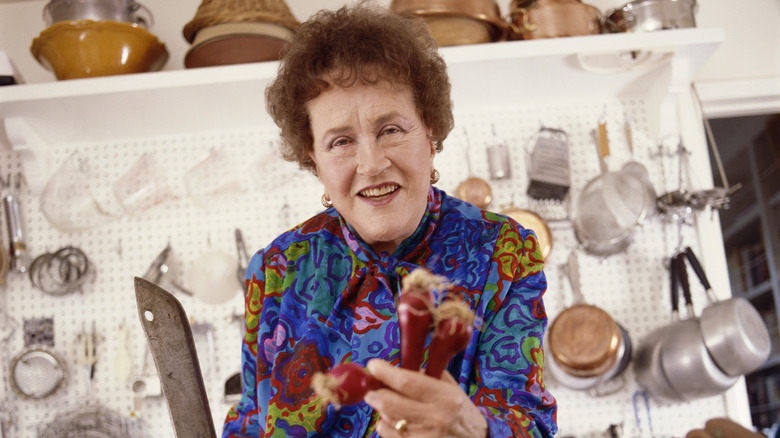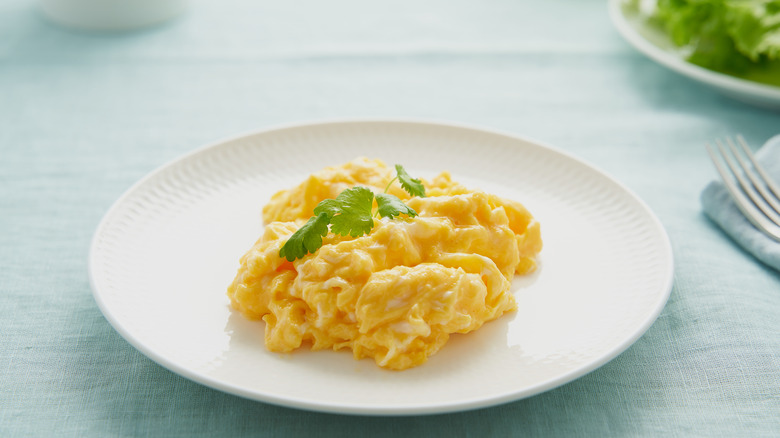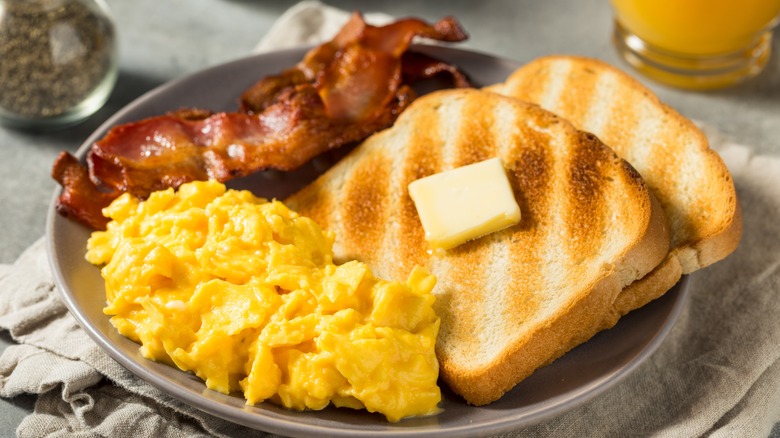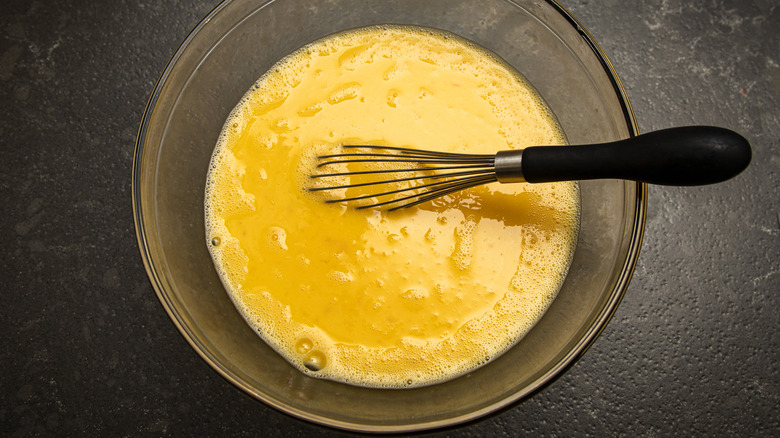Julia Child's Raw Egg Trick For Creamier Scrambles
Julia Child is one of the most famous figures of the food world and is widely associated with impressive classic French dishes like boeuf bourguignon, coq au vin, and sole meunière, but she also offered tips and techniques for making delicious daily meals from simple ingredients. Among these, she is known for her soft scrambled eggs, which rely on cooking the raw eggs in phases, rather than all at once.
Everyone has their own idea of how an egg should be scrambled and cooked — for Julia Child, a perfect plate of scrambled eggs should be soft and creamy. There are different ways to achieve this texture and some cooks prefer to do so by cooking low and slow on the stovetop — which Child did, but she also incorporated another method into her eggs. She recommended setting aside some of the raw egg mixture until just after turning off the fire beneath the pan, so the last bit is only cooked by lingering, residual heat.
How to make Julia Child's soft scrambled eggs
If you want to make scrambled eggs like Julia Child, begin the process just as you normally would. Crack an egg or two into a bowl, whisk them well, then sprinkle with salt and pepper. Salting your eggs at the beginning, rather than just before serving, will help create the creamiest consistency. Adding a spritz of acid can make your scramble extra soft, but it's best to avoid the dairy. Child's version, which doesn't include milk or cream, allows the flavor of the eggs to shine while still producing a silky texture.
Place a pan on the stovetop, turn the heat to low, and add some butter to the pan. Once the butter has melted, pour most — but not all — of the raw eggs into the pan. Cook the eggs for three or four minutes, stirring the whole time. Turn off the heat when the eggs are almost cooked, then pour in the remaining raw egg. Plate the scrambled eggs and serve immediately to enjoy each warm, custardy bite at its best.
Serving a meal centered on a soft scramble
Scrambled eggs are a classic main course for breakfast and brunch, but there is also something delightful about serving eggs for dinner. Whatever time of day you choose, there are plenty of ways to make a full meal centered around scrambled eggs. You can take some inspiration from Julia Child's French culinary training and enjoy your eggs with brioche, croissants, or other fluffy, buttery pastries, but it can also be fun to create some contrast to the creamy consistency of the eggs. Child serves hers with a side of smoked salmon, which is a nice salty pairing, but sausage, fried seitan, or even glazed ham steaks can round out a scrambled egg meal.
Because Child's scramble is so soft, try playing with texture by adding some crunchy, crispy bites to the table. Bacon is a perfect pair, as is a good slice of toast. If you're making a few side dishes and preparing drinks, such as coffee or tea, too, it can be tricky getting the serving timing right. The best option is to mix the eggs, and then prepare everything else before cooking them.
More tips for cooking soft scrambled eggs
Julia Child's technique primarily revolves around timing and temperature, but delving into the details of her simple recipe reveals much more about the secrets to creating a spectacularly soft scramble. To begin, it's noteworthy that she doesn't crack her eggs directly into the frying pan and mix them there. It's worth using an extra bowl to whisk the eggs first, then pour them into the pan. This not only makes it easier to reserve some raw egg to add later, but also aids in the scrambling process, crucial for two reasons: aeration and uniformity. Taking the time to whisk your eggs thoroughly incorporates air, and blends the egg whites with the yolks for a cloud-like, evenly golden scramble.
Another pro tip from Julia Child is apparent in the ingredient list — the only dairy she recommends is the butter for greasing the pan. While it might seem logical to assume that the creamiest, softest scramble would come from adding milk or heavy cream, the reality is quite the opposite. Introducing liquids to the egg mixture increases its moisture content, which can easily lead your scramble to become watery and even rubbery if slightly overcooked, causing the curds to begin to separate. Forgo the additional dairy, and allow the eggs and butter to define the dish's flavor and texture.




